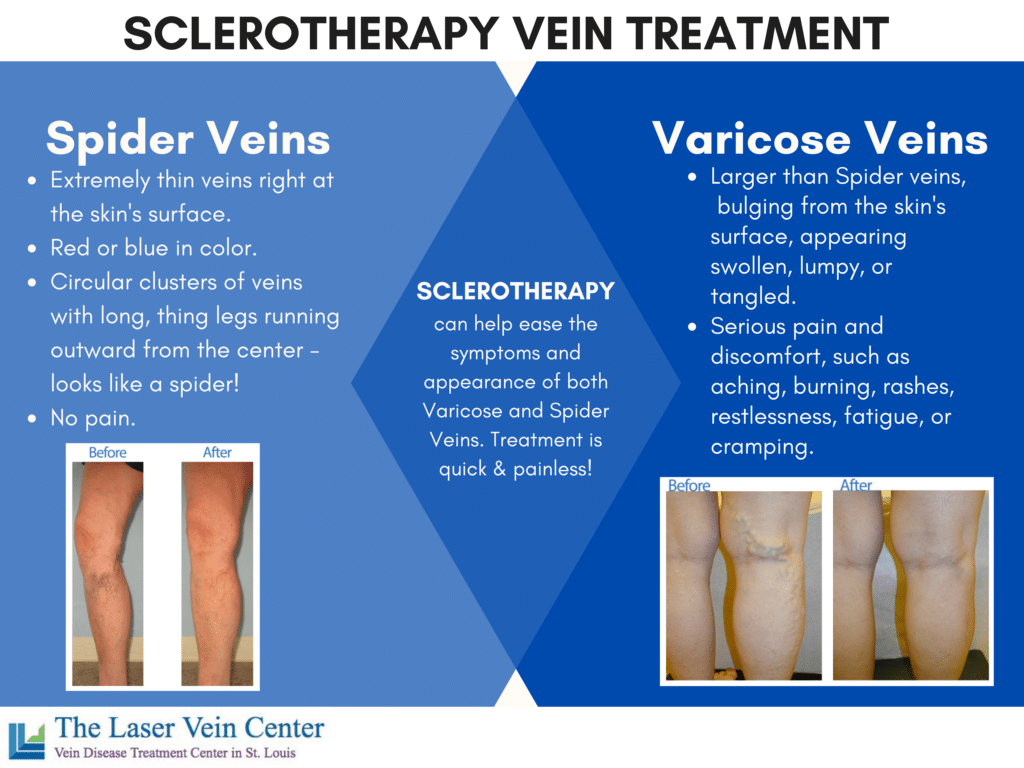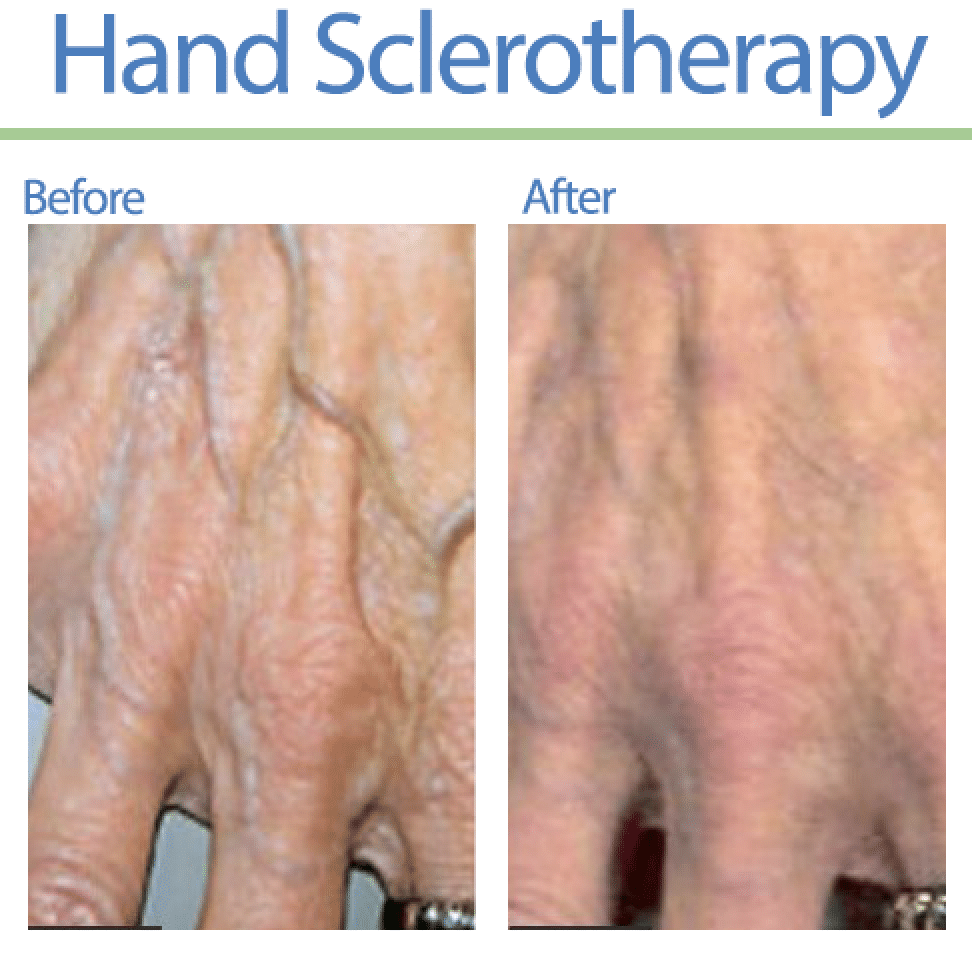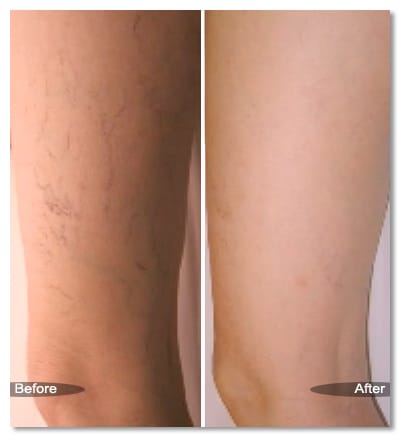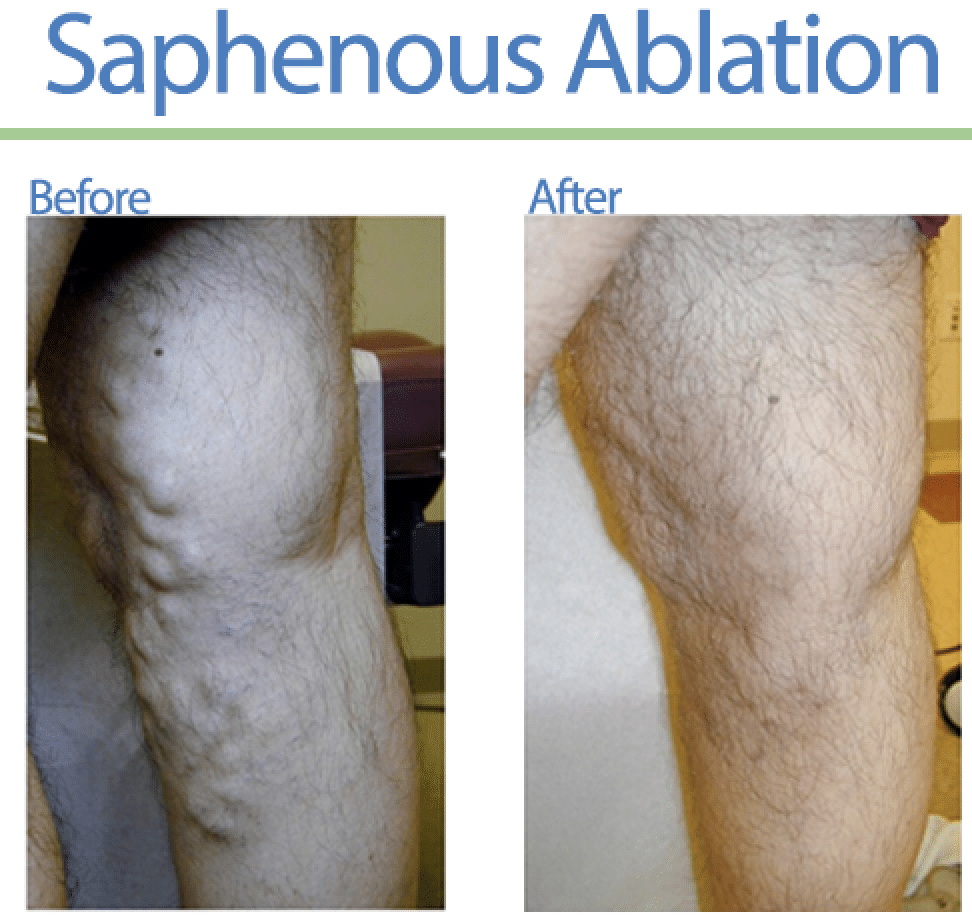To some degree, most of us are familiar with what spider veins and varicose veins are, how they look, and that they aren’t ideal to have. But what many don’t realize until their condition progresses, is that spider veins and varicose veins are more than unsightly – in instances of varicose veins, they can cause serious discomfort, fatigue, and even lead to more serious medical conditions such as painful sores or blood clots. Luckily, treatment for both varicose veins and spider veins is relatively simple, painless, and quick. It’s important for those suffering from either of these conditions to be aware of their symptoms, recognize the importance of treatment, and prioritize getting it taken care of (or at the very least reviewed by a healthcare provider) sooner rather than later.
Both spider veins and varicose veins are symptoms behind venous insufficiency, a disease in which veins are not able to push the body’s blood up the legs, towards the heart, as intended. As the blood tries to make its way upward, it gets “stuck” and begins to pool. In turn, spider veins and/or Varicose veins are created. However, while it may seem like spider and varicose veins are terms used interchangeably, they are not one and the same. So, if they are symptoms of the same disease, what’s the difference between the two?
Spider Veins vs. Varicose Veins
First, they differ in size and color. Spider veins are extremely thin veins right at the surface of the skin, and they get their namesake from the spider appearance they make, circular in shape with long, thin legs running outward from the center. They are usually blue or red in color, and rarely cause discomfort to those who have them. They can be treated cosmetically.
Varicose veins, also referred to as chronic venous insufficiency, are larger than spider veins, and are more likely to cause serious pain, discomfort, and medical issues for those who have them. They bulge out from the surface of the skin and appear swollen, lumpy, or tangled. This chronic form of venous insufficiency may be accompanied by a range of painful side effects, such as aching, burning, rashes, restlessness, muscle cramping, and fatigue. They require prompt treatment, otherwise, they may lead to ulcers, blood clots, or other dangerous conditions.

What is Sclerotherapy?
Sclerotherapy is a form of treatment for venous insufficiency, where a liquid is injected into the affected vein. The sclerosant medication often a soap or irritant causes the vessel to harden and swell. As the vessel hardens, blood is trapped and stops flowing. Gradually, these trapped blood and vessel wall fibrose shrink, followed by the shrinking of the vessel itself. Because these varicose veins and spider veins are extremely small and thin, a tiny needle is used to inject small amounts of the liquid sclerosant medication and a very powerful magnifying glass with strong circular light is used to get the very best view of the target thread veins or spider veins.
As soon as the sclerosant is inside the vein, the vein needs to be compressed. This is accomplished by compression stockings. By shrinking the veins, sclerotherapy reduces the effects of vein damage, making varicose veins less visible, less painful, and decreases the chances of this condition leading to more serious conditions. Ultimately, the liquid destroys the spider and/or varicose veins and causes them to disappear over time.

What is Sclerotherapy treatment like?
Sclerotherapy treatment is mostly pain-free, given how tiny the needles for injection are. Because anesthesia is not usually necessary, the procedure is very safe, and can often be performed in your doctor or dermatologist’s office as an outpatient procedure, allowing you to return home shortly after completing the procedure. During treatment, the patient lies on their back with their legs up, the doctor cleans and disinfects the treatment area, and inserts the tiny needle into the affected veins. Pinching sensations are normal, but nothing too extreme. Burning or tingling can also accrue, but some patients report feeling nothing during the entire procedure.
After the liquid has been injected, some doctors will also massage the treated area to ensure the blood does not re-enter the area and re-recreate the varicose or spider vein. Some patients need to wear compression stockings or some form of padding after treatment, and many doctors recommend compression long-term to avoid recurrence for those prone to developing more spider or varicose veins. Some veins require follow-up treatments to ensure the vein has been fully collapsed, but this is highly situational and depends on the patient and the vein being treated. If there are numerous varicose veins being treated, it’s more likely multiple treatment sessions will be necessary.
While some patients report feeling sore after treatment, the more active patients can be post-treatment, the better. Remaining active will assist in preventing blood clotting during this time post-treatment.

Is Sclerotherapy right for you?
Sclerotherapy is a successful treatment for both spider veins and varicose veins, and luckily in both instances, it’s a simple, quick, and painless procedure. The procedure does not usually require anesthesia or any special preparation, and patients need little to no downtime. However, prior to deciding on treatment, it’s essential to have your veins closely inspected by your doctor to determine which you have, and only after they conduct the proper exam, which may include additional procedures such as ultrasounds or other exams, will your doctor be able to determine next steps safely. For example, in some instances, there are “hidden” varicose veins deeper in the skin, that can unknowingly be feeding other smaller veins or vessels that can present as spider veins, but in reality, are more dangerous.
Sclerotherapy treatment is ideal when the spider veins or varicose veins occur in parts of the body that are below the heart, such as the legs or lower body. When these veins occur on the face or upper body above the heart, other treatment options may be more ideal. However, this is something patients should discuss with their doctor in order to determine the appropriate treatment.

Not everyone who has spider veins or another condition that can be treated with sclerotherapy needs to have the procedure. We highly encourage everyone to first discuss their symptoms and treatment options with their doctor to decide if it is necessary. Spider veins, being the less distressing or painful outcome of venous insufficiency, offers more flexibility for those with the disease. Because the condition is less severe and does not create other health problems, patients can decide to leave them alone, or treat them cosmetically. While we always recommend monitoring them and seeking medical clarification for which type you have, ultimately this is the less severe and dangerous condition.
Sclerotherapy should be considered when any of the following apply:
- Your veins are painful
- Your legs are sore or feel heavy
- The skin on your legs or feet is patchy or dry
- You have a rash near the veins
Are there risks to Sclerotherapy?
Sclerotherapy is a safe procedure and is far less invasive or risky when compared to surgery that requires anesthesia and longer recovery times. However,a s with all medical procedures, there can occasionally be complications and Microsclerotherapy might not give the results that are required.
In general, patients need several sessions to get the optimal result and quite often the best results are only seen after a minimum of two to three months, as the veins take time to heal and the red or blue colors and swelling fade. Some patients will experience browning around the treated areas, but this is typically an occurrence when patients don’t continue compression therapy for the recommended period of time and stop wearing their stocking or padding prematurely. When sclerotherapy does not work, additional treatments, including surgery, may be needed.
The most common negative reactions to sclerotherapy include bruising, redness, and pain near the injected vein. Some patients develop small branches of blood vessels surrounding the injected vein, but they typically disappear on their own over time.
Is Sclerotherapy Treatment for Spider & Varicose Veins Covered by Insurance?
Insurance coverage for sclerotherapy depends on whether an insurer determines if the procedure is medically necessary in your specific case, and under your specific coverage. For this reason, it’s extremely important to work with your doctor to set up a treatment plan so that they can assist you in ensuring you get as much coverage as possible from your insurance provider.
For some insurance providers, spider veins are determined to be more cosmetic than medically necessary in nature, since their treatment is primarily to remove the visibility rather than for health safety. In this case, many insurance companies will consider the procedure non-essential for overall health, and treatment costs may not be covered. Some insurers may require people to try other procedures before trying sclerotherapy, such as cryotherapy to freeze the veins.
However, if a patient has a diagnosed underlying vein condition such as varicose veins, venous insufficiency, or chronic venous insufficiency, it is very likely that costs will be covered under an insurance plan. Similarly, if a physician notices discrepancies in spider vein patterns at the initial consultation that might indicate a more serious condition, it’s possible an insurance provider may consider treatment essential and cover the cost of the procedure. Make sure to check with your specific insurance provider when you’re considering vein treatment services to see if reduced cost options or covered treatments are a part of your plan.
Important Safety Notes
Modern advances in technology mean the treatment of spider veins has become an extremely effective, time-efficient and successful experience for patients. Many procedures take less than an hour and can be performed in the comfort of the attending physician’s office. Requiring little more than local anesthetic, patients undergoing these treatments don’t need to worry about an extensive hospital stay, risks associated with general anesthesia or painful side effects and recovery time. These highly effective treatments allow patients to walk out of the office unassisted after a procedure and provides the freedom to resume normal everyday activities within only a few hours. Additionally, patients experience a peace of mind knowing that these procedures are treating vein conditions at the source and not merely slowing down progress.
Treating patients suffering from vein-based conditions, the professionals at the St. Louis Vein Treatment Center understand what it means to deliver top of the line patient care. Solutions should be customized to each patient’s personal situation and our staff makes sure to provide a comprehensive plan each visit. Presenting our patients with options that are minimally invasive, safe and effective we’re on the cutting edge of vein treatment options and our patients continuously benefit from life-changing results.
References
American Academy of Dermatology, “Dermatologists have a leg up on newer minimally invasive treatments for leg veins.” News release issued July 31, 2013.
Moul DK, Housman L, et al. “Endovenous laser ablation of the great and short saphenous veins with a 1320-nm neodymium: yttrium-aluminum-garnet laser:” J Am Acad Dermatol. 2014;70:326-31.
Nijsten T and van den Bos RR, et al. “Minimally invasive techniques in the treatment of saphenous varicose veins.” J Am Acad Dermatol. 2009;60:110-9.

